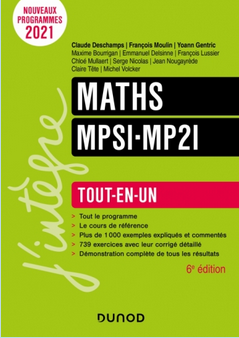Après avoir justifié l'existence de cette suite,
La fonction :
\[
f : \fonction{\mathopen{[}-1,+\infty\mathclose{[}}{\R}{x}
{\ds \sqrt{1+x}}
\]
est continue et strictement croissante,
et elle a pour image :
\[
f\big(\mathopen{[}-1,+\infty\mathclose{[}\big)
=\mathopen{[}0,+\infty\mathclose{[}
\subset\mathopen{[}-1,+\infty\mathclose{[}.
\]
Ainsi, l'intervalle $\mathopen{[}-1,+\infty\mathclose{[}$ est stable par $f$,
et donc, pour tout réel $a\in\mathopen{[}-1,+\infty\mathclose{[}$,
il existe une unique suite $u$ vérifiant :
\[
u_0=a \et \forall{n\in\N}\quad u_{n+1}=\sqrt{1+u_{n}}.
\]
on peut déterminer la seule limite finie possible.
Il suffit de résoudre l'équation :
\[
\ell = \sqrt{1+\ell}
\]
en insistant sur deux points :
la fonction :
$$f:\mathopen{[}-1,+\infty\mathclose{[}\to\R$$
est continue, et l'intervalle
$\mathopen{[}-1,+\infty\mathclose{[}$ est fermé.
Solution
Comme $f$ est continue sur l'intervalle fermé $\mathopen{[}-1,+\infty\mathclose{[}$,
si cette suite $u$ converge, alors sa limite $\ell$ doit vérifier :
\[
\ell = \sqrt{1+\ell}.
\]
On en déduit que $\ell$ est positif et vérifie :
\[
\ell^{2} = 1+\ell
\]
ou encore :
\[
\ell^{2} - \ell - 1 = 0,
\]
dont la seule solution positive est :
\[
\ell = \frac{1+\sqrt{5}}{2}\cdot
\]
Ensuite, on peut directement prouver que la suite converge.
Comme on connaît la seule limite possible, le premier
réflexe doit être $\ldots$
$\ldots$ de chercher à majorer :
\[
|u_{n}-\ell|.
\]
Pour ce faire, il est bon d'écrire :
\[
u_{n}-\ell = \sqrt{1+u_{n-1}}-\sqrt{1+\ell}
\]
puis $\ldots$
$\ldots$ de multiplier par la quantité conjuguée.
et enfin $\ldots$
$\ldots$ de majorer la valeur absolue par une suite géométrique.
Solution
Montrons directement que la suite $u$ converge vers $\ell$.
Soit $n\in\N$. On a :
\[
u_{n+1} -\ell = \sqrt{1+u_{n}} -\sqrt{1+\ell}.
\]
Comme :
\[
\sqrt{1+u_{n}} +\sqrt{1+\ell} \geq \sqrt{1+\ell} >0
\]
la quantité précédente est égale à :
\[
\frac{(\sqrt{1+u_{n}} -\sqrt{1+\ell})\,(\sqrt{1+u_{n}} +\sqrt{1+\ell})}
{\sqrt{1+u_{n}} +\sqrt{1+\ell}}
\]
et donc à :
\[
\frac{u_{n} -\ell}{\sqrt{1+u_{n}} +\sqrt{1+\ell}}\cdot
\]
On en déduit :
\[
|u_{n+1} -\ell| = \frac{|u_{n} -\ell|}{\sqrt{1+u_{n}} +\sqrt{1+\ell}}
\]
et donc :
\[
|u_{n+1} -\ell| \leq \frac{|u_{n} -\ell|}{\sqrt{1+\ell}} \cdot
\]
Une récurrence immédiate donne alors :
\[
\forall{n\in\N}\quad |u_{n} -\ell| \leq \frac{|u_{0} -\ell|}
{\big(\sqrt{1+\ell}\,\big)^{n}}\cdot
\]
Comme $ \sqrt{1+\ell} > 1$, on en déduit
que $u_{n}-\ell$ tend vers $0$ et donc que la suite $u$ converge vers $\ell$.
Mais on peut aussi montrer que $u$ est monotone,
puis appliquer le résultat fondamental sur les suites monotones.
On peut facilement justifier ce que l'on voit sur le dessin.
- Si $u_{0}\in I_{1} = \mathopen{[}-1,\ell\mathclose{]}$, alors
tous les $u_{n}$ sont dans $I_{1}$, et la suite est croissante.
- Si $u_{0}\in I_{2} = \mathopen{[}\ell,+\infty\mathclose{[}$, alors
tous les $u_{n}$ sont dans $I_{2}$, et la suite est décroissante.
Pour justifier cela, le plus simple est de prouver :
Fin de la solution avec cette méthode
-
- Le tableau de variations de $f$ :
\[
\begin{array}{|c|rcccc|}
\hline
x & -1& &\ell & &+\infty\\
\hline
& & & & &+\infty\\\
& & & &\nearrow &\\
f & & &\ell & &\\
& &\nearrow & & &\\
&0 & & & &\\
\hline
\end{array}
\]
montre que les intervalles :
\[
I_{1} = \mathopen{[}-1,\ell\mathclose{]}
\et
I_{2} = \mathopen{[}\ell,+\infty\mathclose{[}
\]
sont stables par $f$ puisque :
\[
f(I_{1})=\mathopen{[}0,\ell\mathclose{]}\subset I_{1}
\et
f(I_{2})=I_{2}.
\]
- Étudions le signe de $f(x)-x$.
-
- Pour tout $x\in\mathopen{[}-1,0\mathclose{]}$, on a évidemment :
\[
f(x)-x = \sqrt{1+x}-x \geq \sqrt{1+x} \geq 0.
\]
- Supposons $x\in\mathopen{[}0,+\infty\mathclose{[}$. Alors :
\begin{align*}
f(x)-x &= \sqrt{1+x}-x \\ \\
&= \frac{1+x-x^{2}}{\sqrt{1+x}+x}
\end{align*}
est du signe de :
\[
u(x) = 1+x-x^{2} = -(x-\ell)\,(x-\ell')
\]
avec :
\[
\ell = \frac{1+\sqrt{5}}{2} >0
\et
\ell' = \frac{1-\sqrt{5}}{2} <0.
\]
Par suite, on a :
\[
\forall{x\in\mathopen{[}0,\ell\mathclose{]}}\quad u(x) \geq 0
\]
et :
\[
\forall{x\in I_{2}}\quad u(x) \leq 0.
\]
On en déduit :
\[
\forall{x\in I_{1}}\quad f(x) \geq x
\Et
\forall{x\in I_{2}}\quad f(x) \leq x.
\]
- Supposons $u_{0}\in I_{1}= \mathopen{[}-1,\ell\mathclose{]}$.
Comme $I_{1}$ est stable par $f$, on en déduit :
\[
\forall{n\in\N}\quad u_{n}\in I_{1}
\]
et donc :
\[
\forall{n\in\N}\quad u_{n+1} = f(u_{n}) \geq u_{n}.
\]
La suite $u$ est alors croissante et majorée par $\ell$,
on en déduit qu'elle est convergente. Elle converge donc
vers sa seule limite possible $\ell$.
- Supposons $u_{0}\in I_{2}= \mathopen{[}\ell,+\infty\mathclose{[}$.
Comme $I_{2}$ est stable par $f$, on en déduit :
\[
\forall{n\in\N}\quad u_{n}\in I_{2}
\]
et donc :
\[
\forall{n\in\N}\quad u_{n+1} = f(u_{n}) \leq u_{n}.
\]
La suite $u$ est alors décroissante et minorée par $\ell$,
on en déduit qu'elle est convergente. Elle converge donc
vers sa seule limite possible $\ell$.
